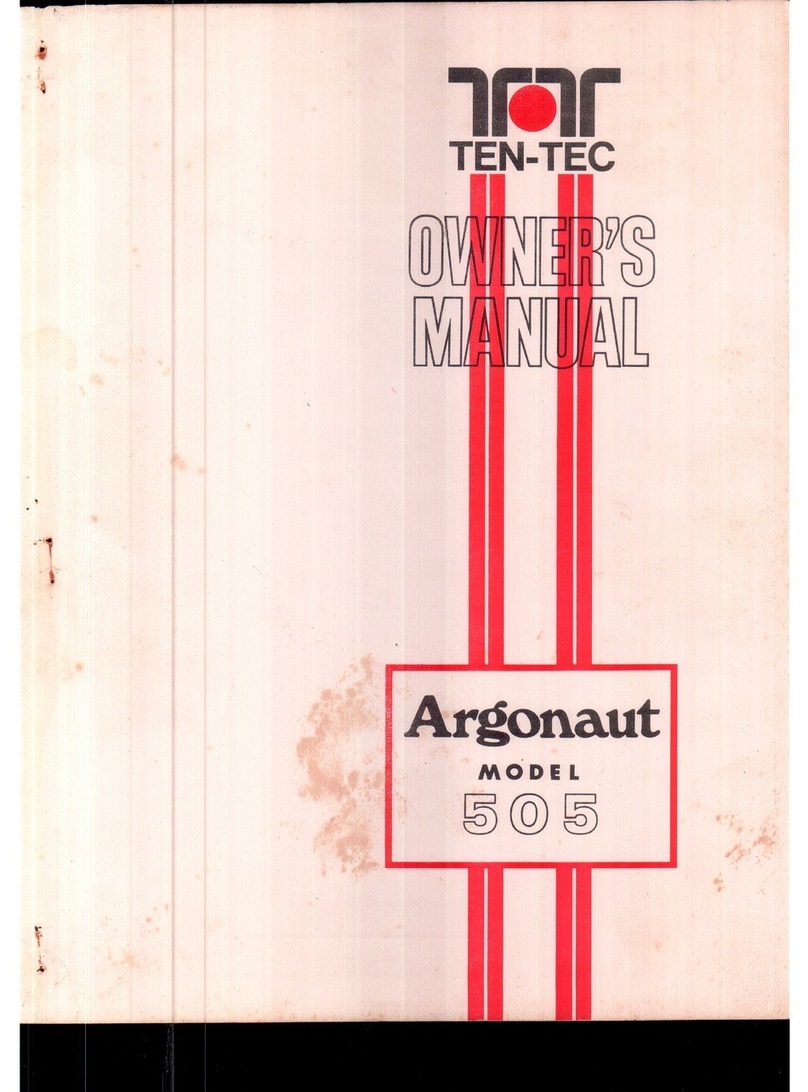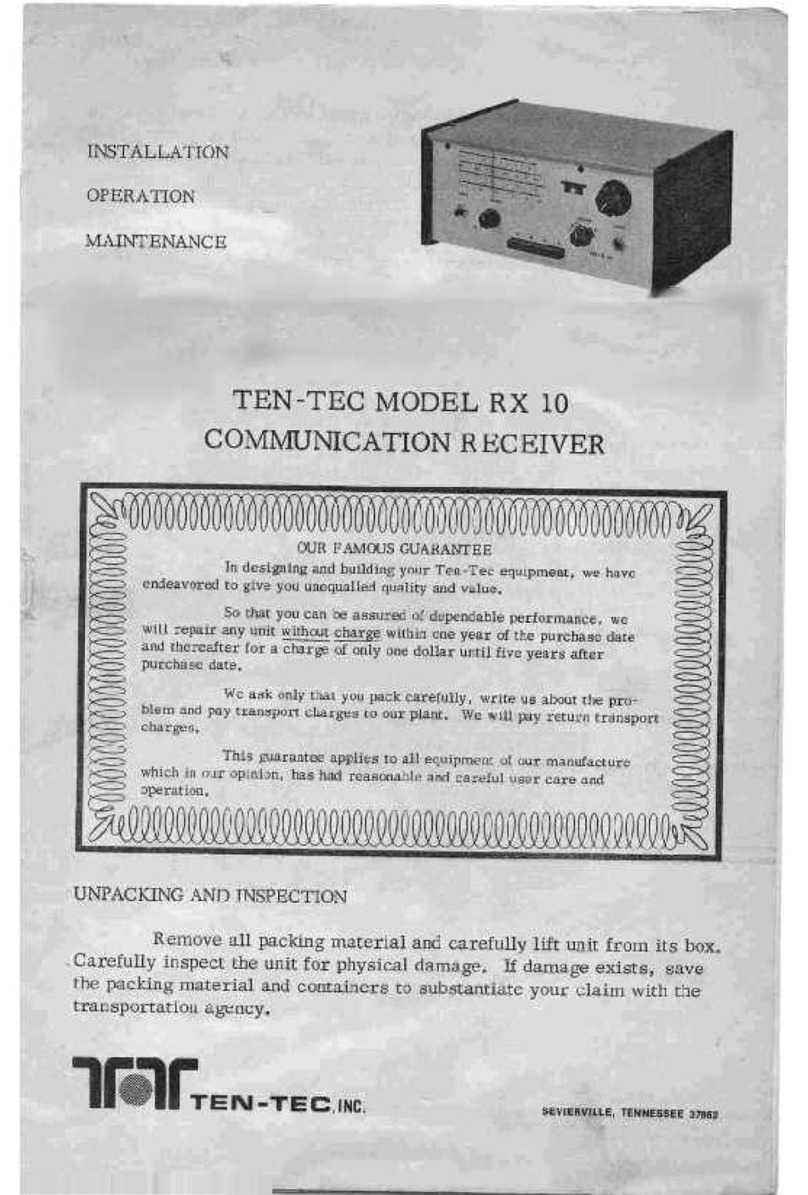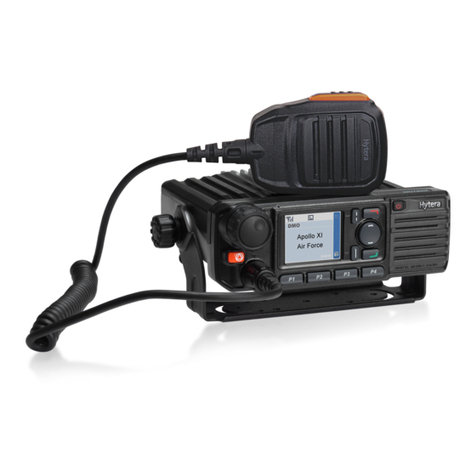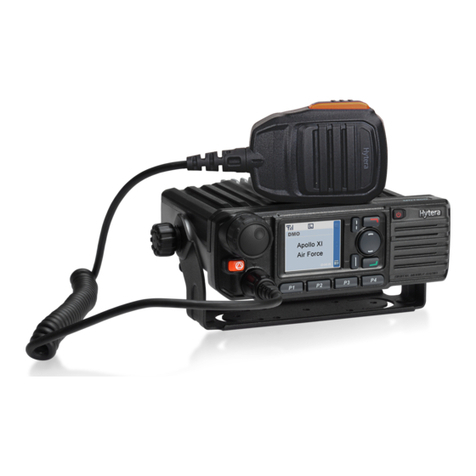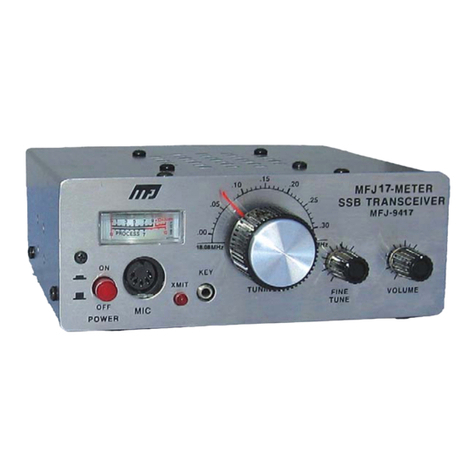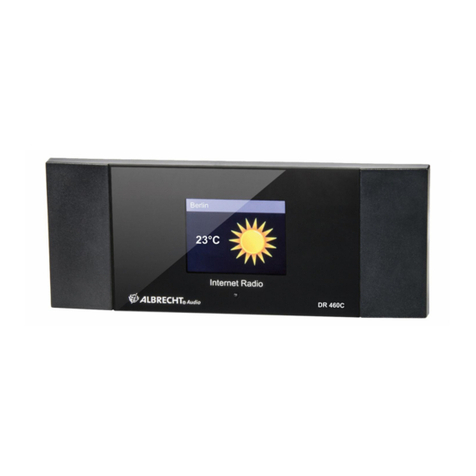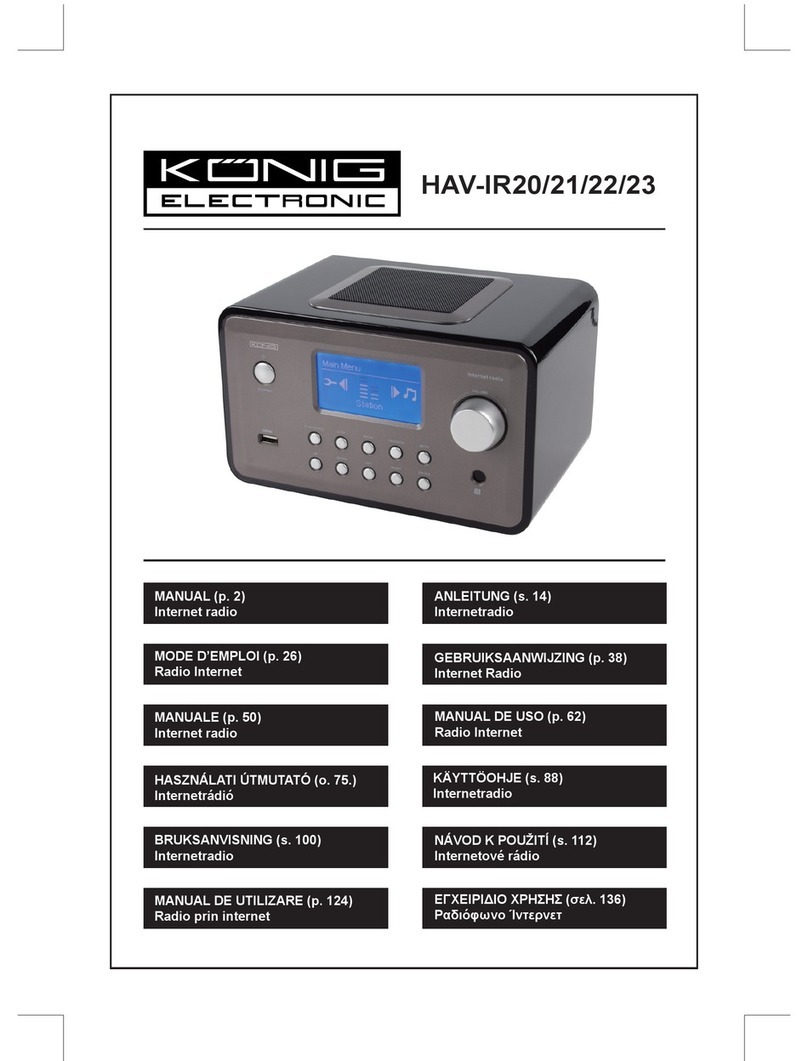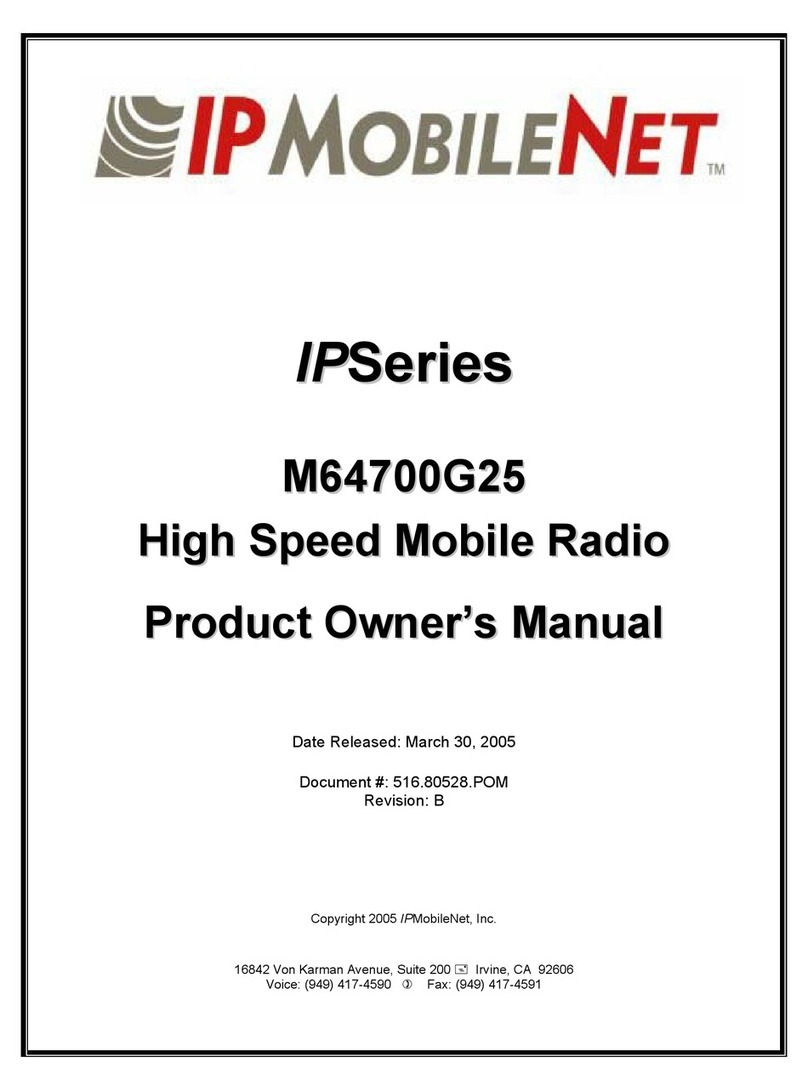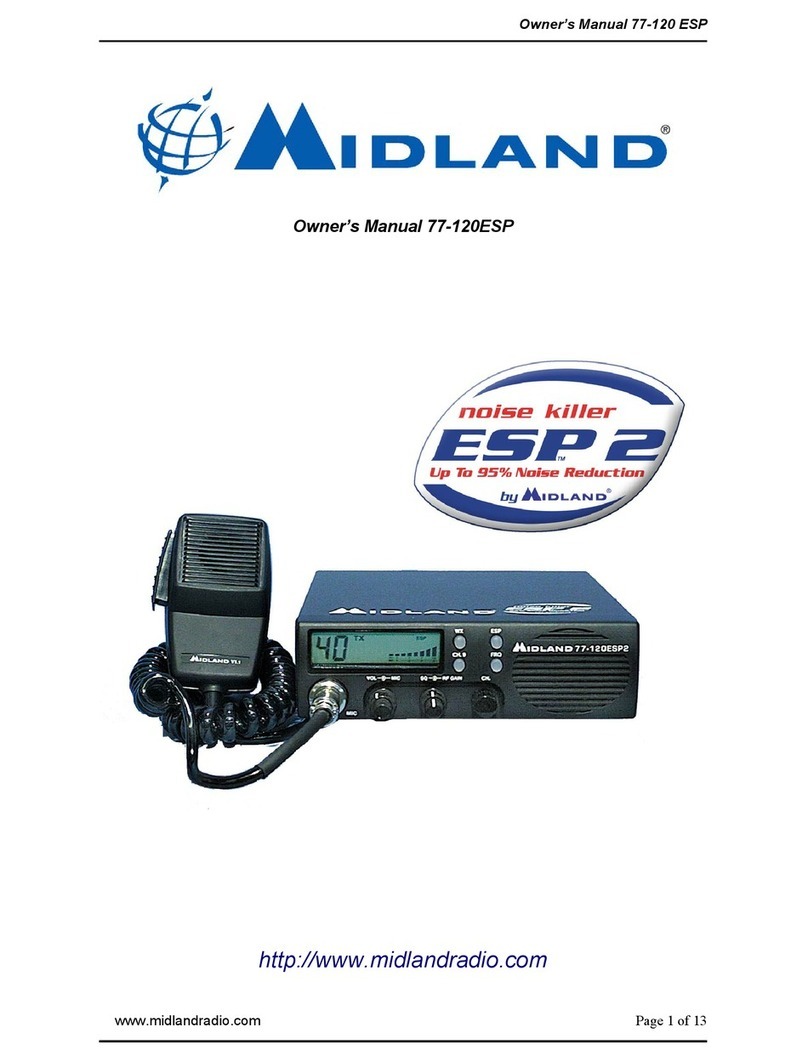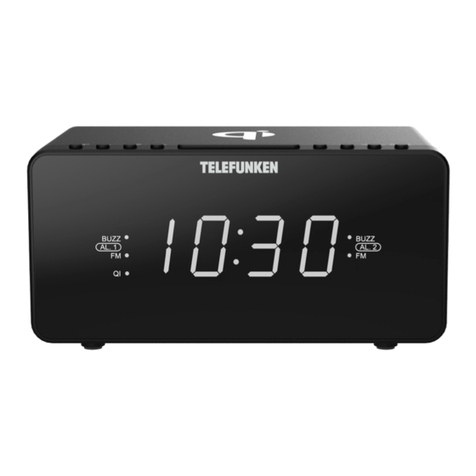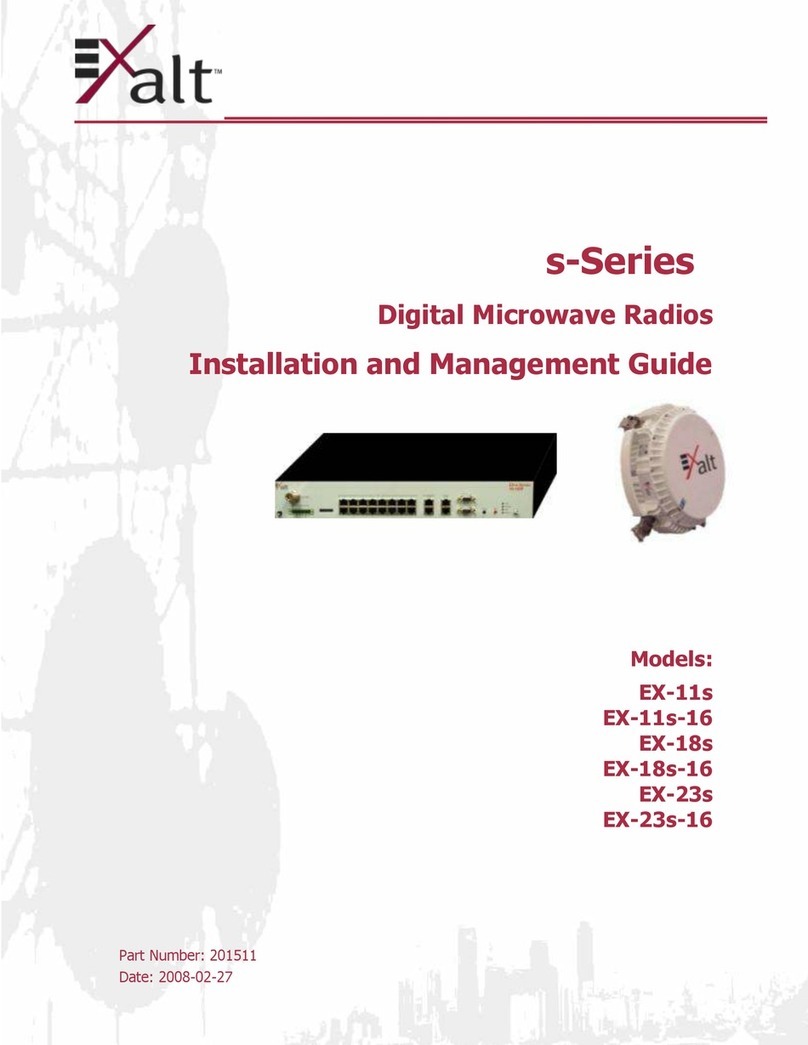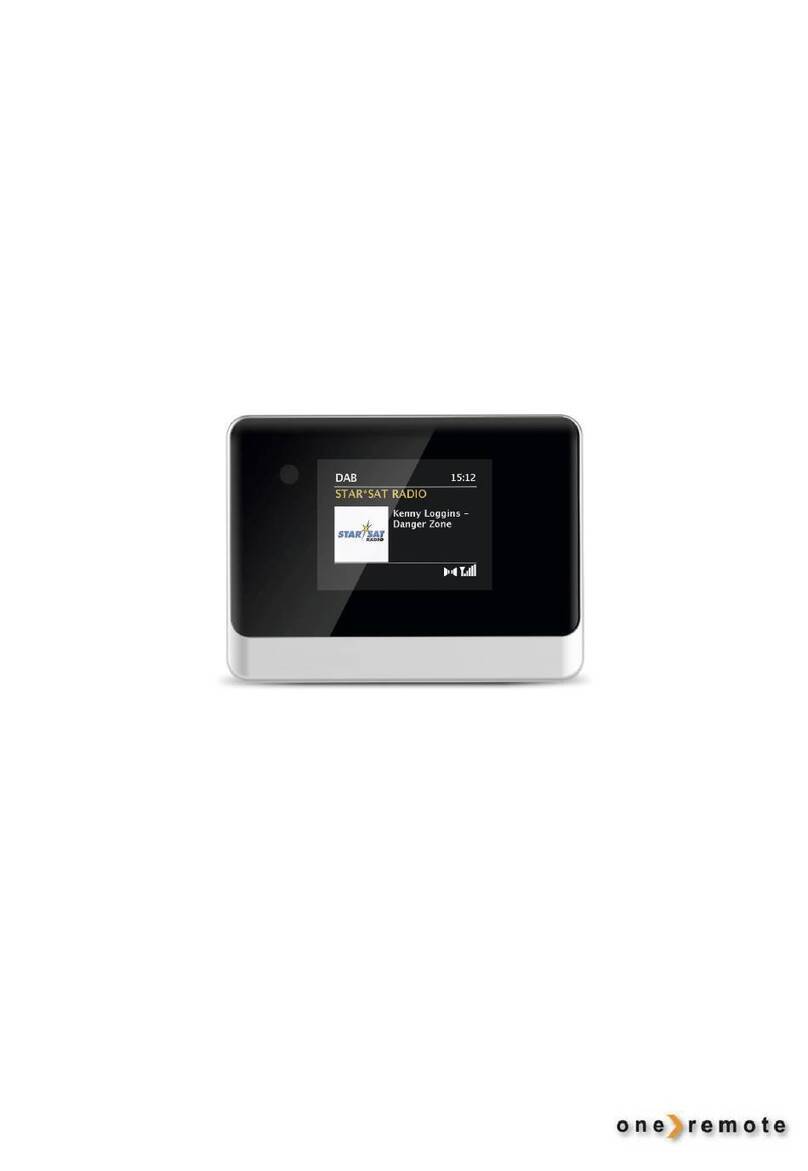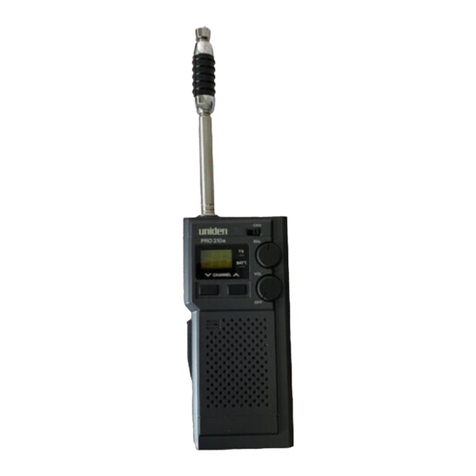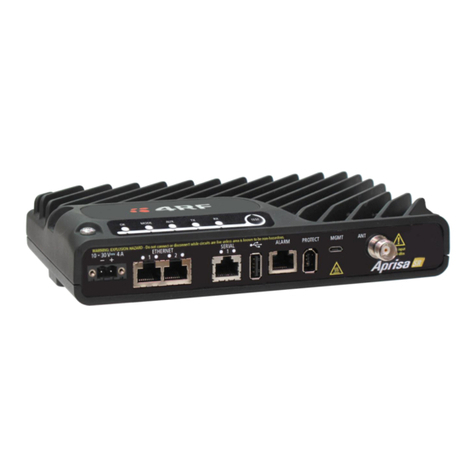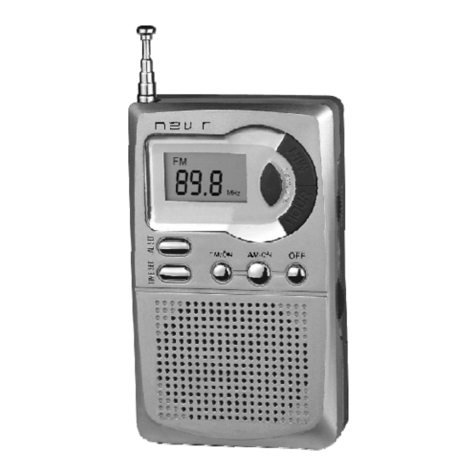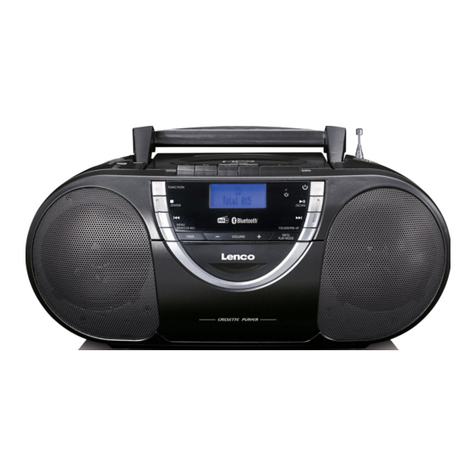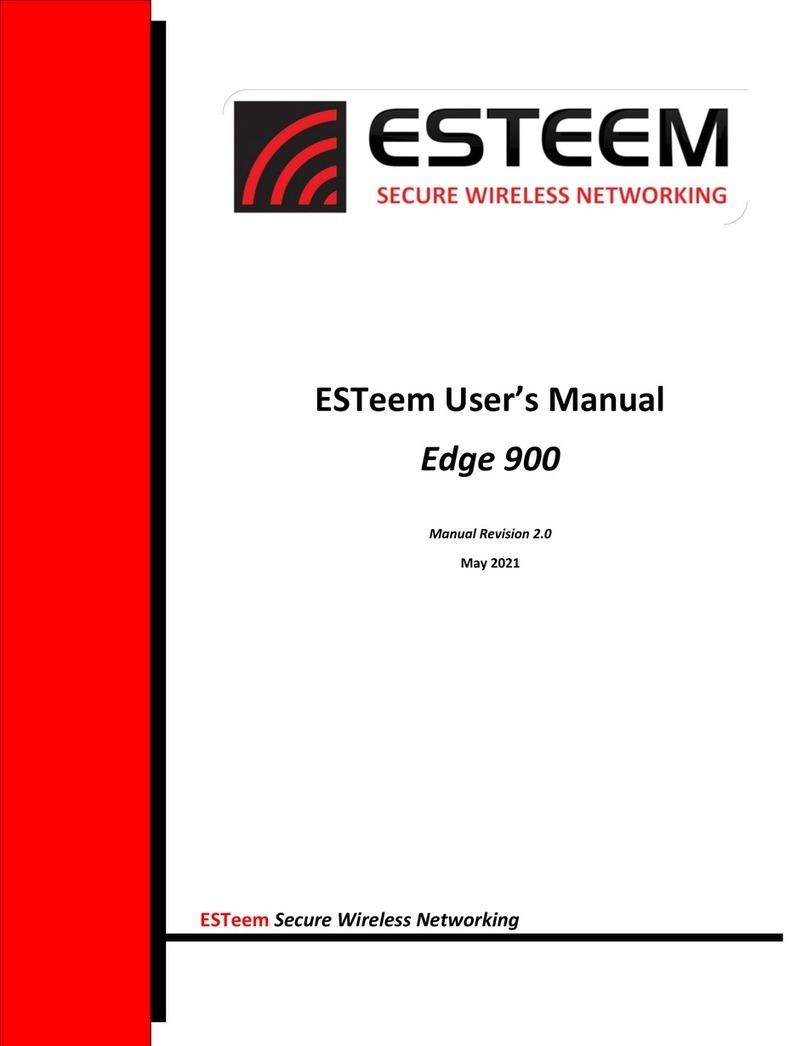Ten-Tec OMNI-VII 588 User manual

Rev 1.009 OMNI-VII Programmer’s Reference Guide 1 of 63
OMNI-VII Firmware Updates at www.rfsquared.com
OMNI-VII
Model 588
Programmers
Reference
Guide
Revision 1.009

Rev 1.009 OMNI-VII Programmer’s Reference Guide 2 of 63
OMNI-VII Firmware Updates at www.rfsquared.com
Introduction..................................................................................................................4
Conventions Used in This Manual ...........................................................................6
Interface Settings ......................................................................................................7
Serial Connection ..................................................................................................7
Ethernet Connection..............................................................................................8
The OMNI-VII Command Set ..................................................................................... 9
OMNI-VII Command Set Quick List.....................................................................10
RADIO MODE Command Set ............................................................................... 15
Frequency Tuning................................................................................................15
AGC Mode Control.............................................................................................16
Squelch (all mode)...............................................................................................16
RF Gain ...............................................................................................................17
RF Attenuation Control.......................................................................................17
Noise Blanker, Noise Reduction, and Automatic Notch..................................... 18
Receive and Transmit Modes..............................................................................18
Passband Tuning (PBT).......................................................................................19
AF (Audio Volume) ............................................................................................19
Version – Query Only .........................................................................................20
Receive Filter ......................................................................................................20
Where – AT.........................................................................................................21
Execution Control ...............................................................................................21
SUNIT – Query Only .......................................................................................... 22
Transmit...............................................................................................................23
Split State – Radio Mode.....................................................................................24
Main Mode Query – Orion Format .....................................................................24
REMOTE MODE Command Set ...........................................................................25
Ethernet Settings – Query Only...........................................................................26
Frequency Tuning................................................................................................27
Receive / Transmit Offset....................................................................................28
Audio Source.......................................................................................................29
Keying Loop On/Off ...........................................................................................30
CW RISE/FALL TIME.......................................................................................30
Mic Gain..............................................................................................................31
Line Gain.............................................................................................................31
Speech Processor.................................................................................................32
FM CTCSS Tones ...............................................................................................32
RX Equalizer.......................................................................................................33
TX Equalizer .......................................................................................................33
Transmit Roll Off................................................................................................34
External T/R Delay..............................................................................................34
Sidetone Frequency.............................................................................................35
CW QSK Delay...................................................................................................35
Transmit Enable ..................................................................................................36
Sideband Transmit Bandwidth ............................................................................37
Auto Tuner ..........................................................................................................38

Rev 1.009 OMNI-VII Programmer’s Reference Guide 3 of 63
OMNI-VII Firmware Updates at www.rfsquared.com
Sidetone Volume.................................................................................................38
SPOT Volume .....................................................................................................39
FSK Mark High/Low...........................................................................................39
I-F Filter Selection...............................................................................................40
I-F Filter Enable ..................................................................................................40
Antenna ...............................................................................................................41
Monitor................................................................................................................41
Transmit Power ...................................................................................................42
SPOT Tone On/Off .............................................................................................42
PREAmp On/Off.................................................................................................43
Remote Tune .......................................................................................................43
Split State – Extended Format.............................................................................44
VOX TRIP Level.................................................................................................44
ANTI VOX Level................................................................................................45
VOX Hang Time .................................................................................................45
CW Keyer Mode .................................................................................................46
CW Keyer Weighting..........................................................................................46
Manual NOTCH On/Off .....................................................................................47
Manual NOTCH Center Frequency ....................................................................47
Manual NOTCH Width.......................................................................................48
Internal Keyer Speed...........................................................................................48
VOX On/Off........................................................................................................49
RADIO DISPLAY ON/OFF ...............................................................................49
RADIO SPEAKER ON/OFF ..............................................................................50
TRIP Gain............................................................................................................50
Operation with Optional 302 Remote Encoder..........................................................51
POD PASSTHRU Command .................................................................................51
POD PASSTHRU Notification...............................................................................52
POD ENCODER Notification ................................................................................ 53
Serial Device Control via Ethernet ............................................................................54
Serial Pass Thru ......................................................................................................54
Serial Echo Mode ...................................................................................................55
CWType.....................................................................................................................57
Ethernet Audio ........................................................................................................... 59
RIP (Radio over IP) Introduction ...........................................................................59
TRIP (Transmit over IP) Introduction ....................................................................59
RIP Audio Packet Format.......................................................................................60
TRIP Audio Packet Format ....................................................................................61
Ethernet Command/Query Format.............................................................................61
Document Revision History.......................................................................................62

Rev 1.009 OMNI-VII Programmer’s Reference Guide 4 of 63
OMNI-VII Firmware Updates at www.rfsquared.com
Ten-Tec has produced this document as a starting point for software developers
undertaking the development of a PC based OMNI-VII (Model 588) Interface program.
The Ten-Tec OMNI-VII DSP HF transceiver is a product that is defined more by
firmware than hardware. As such, it is subject to change based on customer needs. It is
advisable to check for a more recent update at the Ten-Tec firmware update site,
www.rfsquared.com. This specification is intended for OMNI-VII Version 1.005 or later.
There are two levels of command interface protocols provided. The two levels of
commands are designed for two different operating modes of the OMNI-VII.
The first Operating Mode is referred to as “RADIO MODE”. In “RADIO MODE”
only the base level of commands is available, and they are available only on the Serial
Interface. This is the command-set that is already utilized by the Jupiter in Jupiter mode.
A few of these commands have a parameter list that is extended to encompass added
items for that command. This makes the base level of the OMNI-VII in Radio Mode
compatible with control programs that already exist. The purpose of “RADIO MODE” is
for the radio user who wants to control the rig traditionally from the front panel.
Changing frequencies, watching the Power Meter, switching bands, and adjusting the
myriad of other controls, just like it is done with an Orion or Jupiter.
The second Operating Mode is referred to as “REMOTE MODE”. In order to get
fully functional control of all of the OMNI-VII’s operating parameters, then it is
necessary to operate the OMNI-VII in “REMOTE MODE”. In this mode, the full
command set is available on the Ethernet interface, and also the serial port. The purpose
for “REMOTE MODE” is to be able to control the radio 100% through the Serial and/or
Ethernet interfaces. “REMOTE MODE” also provides for the audio streaming features
of RIP and TRIP.
RIP is an acronym for Radio over IP. This is the receive audio that is heard via the
OMNI-VII’s speaker. In the case of the REMOTE Mode radio, this audio is then RIP’d
from the OMNI-VII via the Ethernet to a computer for playback on the computer’s
speaker.
TRIP is an acronym for TRansmit audio over IP. Normally, transmit audio comes
from a microphone on the radio and is transmitted over the air by the radio. In the
instance of the Ethernet, it is the audio recorded on a microphone on a computer, and then
transmitted on the Ethernet in a packet for the OMNI-VII to subsequently transmit over
the air.
Introduction

Rev 1.009 OMNI-VII Programmer’s Reference Guide 5 of 63
OMNI-VII Firmware Updates at www.rfsquared.com
Since the OMNI-VII provides future growth for up to a total of 6 completely
independent modes. It is possible that even further additions will be made to support the
added capabilities of the other modes.
Holdings down a digit on the band stack keyboard of the front panel accesses each
mode. For “RADIO MODE”, press and hold the “1” digit until you see the Version
string including the word RADIO. For “REMOTE MODE”, press and hold the “2” digit
until you see the Version string including the word REMOTE. If you accidentally press
the wrong number (e.g. 3 through 6), then the OMNI-VII will tell you that this specific
operating mode is not present. If this occurs, then you should turn off the OMNI-VII, and
try again. If you accidentally press any other key, then you won’t see the radio version
string displayed, instead you will have forced the radio to remain in “BOOT LOADER
MODE”. Again, turn off the radio, and try again making sure you hold down the proper
key to get to the proper mode.
To add more value to a remote based radio, the OMNI-VII has the capability of
accepting Ethernet commands that are intended to be delivered to a serial device, such as
a SteppIR Antenna Controller. This is referred to as “Serial Passthru”. The OMNI-VII
also has the capability of being put into a mode where any data it receives in on the serial
port, it can echo back to the Ethernet port. This is referred to as “Serial Echo”. This
makes it possible for a remotely placed OMNI-VII to be capable of being a portal to
controlling and getting status from other serial devices at the ham shack.
Another functionality that the OMNI-VII has is the ability to provide a way to send
to the Serial Interface pod key presses. This functionality is invoked when the OMNI-VII
receives a command to tell it to start “POD PASSTHRU”. From that moment on,
anytime a pod key is pressed, the OMNI-VII will not process the key, but will send a
notification out the serial port that a given POD key has been depressed. When released,
notification is sent again out the serial port that the given POD key has been released.
This allows control programs to extend the functionality of the radio with programs
written on the PC. This functionality already exists in other TenTec Transceivers, namely
the Orion, Orion2, and Jupiter and it is already in use by various control program codes
available on the market today.
The command set described in this manual does not include the command set utilized
by the OMNI-VII Boot/Loader program for programming the OMNI-VII. The command
set described in this manual only covers the command set that is utilized for radio
command and control functions.

Rev 1.009 OMNI-VII Programmer’s Reference Guide 6 of 63
OMNI-VII Firmware Updates at www.rfsquared.com
Information contained in this document applies to firmware version 0.114 and later.
Numeric Types:
0x0A Hexadecimal Numbers.
<dn> 8 bit numbers
10 Decimal Number.
‘A’ ASCII character code.
Example: ASCII ‘A’ is 0x41.
<CR> a byte containing the value of <0x0d> for a carriage return
Conventions Used in This Manual

Rev 1.009 OMNI-VII Programmer’s Reference Guide 7 of 63
OMNI-VII Firmware Updates at www.rfsquared.com
Serial Connection
The RS-232 serial interface on the OMNI-VII is handled via a 16C550 UART
located on the DSP/Logic board. The interface parameters are fixed at 57,600 baud, No
Parity, 8 Data bits, 1 Stop bit. The UART uses hardware handshaking to control the data
flow between the PC and the radio. The host PC should be set to use RTS/CTS signaling.
This is the same regardless of whether the topic is command and control interface on
the serial port or using the serial port for serial pass thru or serial echo modes.
The diagram below shows the wiring and associated signals for a 9 pin to 9 pin serial
cable required to connect the OMNI-VII transceiver to a standard PC. If you purchase a
pre-made serial cable it should be a straight through cable.
Computer Pin OMNI-VII
CD. 1 N.C.
RXD 2 Serial Data Out
TXD 3 Serial Data In
DTR 4 N.C.
GND 5 GND
DSR 6 N.C.
RTS (out) 7 RTS (in)
CTS (in) 8 CTS (out)
RI 9 N.C.
COMPUTER OMNI-VII
The serial port of the OMNI-VII is defined as a DCE terminal. Which means that it
is meant to be connected to a Computers DTE terminal. Using a straight through RS-232
control line. If you wish to control another serial device, and if it is a DCE terminal type
of a device also, then the cable you need to use is a null-modem RS232 Interface cable. If
Interface Settings

Rev 1.009 OMNI-VII Programmer’s Reference Guide 8 of 63
OMNI-VII Firmware Updates at www.rfsquared.com
the other device is a DTE, then you will need to use a standard straight RS232 interface
cable.
In order to use the OMNI-VII in remote mode, but you intend on controlling the rig
only by the serial port, then it is suggested that you disable the Ethernet activities of the
OMNI-VII. Setting the first octet of the G8WAY IPADDR to 0 disables Ethernet
activities.
Ethernet Connection
The Ethernet interface on the OMNI-VII is handled via a Realtek RTL8019AS Full
Duplex Ethernet Controller located on the DSP/Logic board. This Network Interface
Controller (NIC) is fully compliant with Ethernet II and IEEE802.3 10Base5, 10Base2,
and 10BaseT. The full-duplex function of the NIC enables simultaneously transmission
and reception on the twisted-pair link to a Full Duplex Ethernet switching hub. This
feature not only increases the channel bandwidth from 10 to 20 Mbps but also avoids the
performance degradation problem due to the channel contention characteristics of the
Ethernet CSMA/CD protocol. This connection is configured for 10Mbps, so it is
compatible with all 10/100 networks.
Depending upon how you want to connect your OMNI-VII to another computer via
the Ethernet Interface, there are two types of cables that you can choose. If you
remember, for serial communications, you either pick a standard serial cable or a null-
modem serial cable. The same is true in principle for Ethernet connections. If you are
going to connect the OMNI-VII directly to a computer, then you will need to use a
“cross-over” Ethernet patch cable. If you are going to connect the OMNI-VII to a hub or
router or gateway, then you will need to use a “standard” Ethernet patch cable.
In either case, you can use either a CAT-5E (350Mhz) high-speed patch cord, or you
can use a CAT-6 Networking Cable. Either will satisfy the bandwidth requirements of the
OMNI-VII. They both follow EIA/TIA 568B Wiring, and are equipped with RJ-45
connectors.

Rev 1.009 OMNI-VII Programmer’s Reference Guide 9 of 63
OMNI-VII Firmware Updates at www.rfsquared.com
The command set is extensive and every effort has been made to keep the individual
commands as simple as possible. Although the OMNI-VII Serial interface operates at
57,600 baud and the Ethernet interface operates at 10Mbps short commands are used to
keep the processing overhead to a minimum.
In general an OMNI-VII instruction is a series of ASCII characters which may be
followed by data and then terminated by a carriage return <CR>. Command characters
are case sensitive! In general, the query are identical to the set command except the
command is prefixed with a ‘?’ character.
The OMNI-VII interface requires that data be in a format compatible with each
command. Programmers should ensure that the supplied data is correct. For the Serial
interface, where a command is unrecognized or data is invalid the radio will send back a
response consisting of the letter ‘Z’ followed by the first character of the command string
that caused the error and finally, a carriage return <CR>. For the Ethernet Interface,
there is no invalid command reply. So it is a best practice if a command is sent, then the
associated query should also be used to verify the new setting.
Because the OMNI-VII is designed so that it could be reprogrammed in-system the
command set presented here is subject to change or enhancement. We will make every
effort to make the system backward compatible with existing documented commands
whenever possible. However, the OMNI-VII is a HF TRASNCEIVER PLATFORM that
could host a variety of radio services. Persons or companies developing control software
for the OMNI-VII should not assume that the radio is operating original factory firmware
but rather should always query the radio firmware revision to ensure compatibility.
There is one specialized query “?*” which is used to query all of the settings,
returned in one response, relevant to the operating mode of the radio. In the Radio Mode,
it will return all of the possible Radio Mode responses, and in Remote Mote, it will return
all possible Remote Mode responses. If performed over the serial port, then this will be a
series of properly formatted packets pertinent to each response. If performed over the
Ethernet then this will be one single Ethernet Packet whose data contains all of the
possible formatted packets pertinent to each response.
The OMNI-VII Command Set

Rev 1.009 OMNI-VII Programmer’s Reference Guide 10 of 63
OMNI-VII Firmware Updates at www.rfsquared.com
Command Set Format
Query Format
Set Note
Query return val
Radio
Mode
Remote
Mode
Set/Get
Main Freq *A<d3 d2 d1 d0> <CR>
?A <CR> d3..d0 4-byte binary
A<d3 d2 d1 d0> <CR> or
@Afnnnnnnnn <CR>
X X
ASCII
Method *A12345678<CR>
?A <CR> up to 8 ASCII #s
Get is 4 byte binary X
n.m
ASCII *An.m<CR>
?A <CR> n.m ascii => n.mMHz
Get is 4-byte binary X
Set/Get Sub
Freq *B<d3 d2 d1 d0><CR>
?B <CR> d3..d0 binary
A<d3 d2 d1 d0> <CR> X X
ASCII
Method *B12345678<CR>
?B <CR> up to 8 ASCII #s
Get is 4-byte binary X
n.m
ASCII *Bn.m<CR>
?B <CR> n.m ascii => n.mMHz
Get is 4-byte binary X
Set/Get
AGC Mode *GX<CR>
?G <CR> X=ASCII ‘0’.. ‘3’
AX <CR> X X
Set/Get
Squelch *H<d0><CR>
?H <CR> range = 0..0x7f
H<d0><CR> X X
Set/Get
RFGain *I<d0><CR>
?I <CR> range = 0..0x7f
I<d0><CR> X X
Set/Get
Attenuator *JX<CR>
?J <CR> X=ASCII ‘0’ .. ‘3’
JX <CR> X X
Set/Get NB,
NR, AN *K nb nr an <CR>
?K <CR> nb=0..7, nr=0..9, an=0..9
K nb nr an <CR> X X
Set/Get
RIT/XIT *L<d2><d1><d0><CR>
?L <CR> <d2>=0..3,<d1d0>=+-8192
L<d2><d1><d0><CR> X
Set/Get
MODE *M VFOA VFOB<CR>
?M <CR> VFOA/B=ASCII ‘0’ .. ‘6’
M VFOA VFOB <CR> X X
Set/Get Split
State *N <d0> <CR>
?N Range = 0..1
N <d0> <CR> X X
Set/Get
Passband
Tuning
*P <d1 d0> <CR>
?P <CR> d1 d0 = 2 byte binary
P <d1 d0> <CR> X X
Get Mode
Orion Form ?RMM <CR> @RMM <d0> <CR> X X
Set Transmit
On/Off *T <d1> <d0> <CR> d1, d0 = binary X X
Set/Get AF *U <d0> <CR>
?U <CR> Range = 0..0x7f
U<d0><CR> X X
OMNI-VII Command Set Quick List

Rev 1.009 OMNI-VII Programmer’s Reference Guide 11 of 63
OMNI-VII Firmware Updates at www.rfsquared.com
Command Set Format
Query Format
Set Note
Query return val
Radio
Mode
Remote
Mode
Set/Get DSP
RX Filter *W <d0> <CR>
?W <CR> Range = 0..0x24
W<d0><CR> X X
Where At (Query only, without ?)
XX <CR> <0x0d><0x0d>
“ RADIO START –
xxxxxx” RADIO OR
REMOTE <0x0d>
X X
Get SUnit ?S <CR>
Also Supports “?F<CR>”
On the first data byte
returned,
If the most significant bit
= 1 means returning
transmit power.
If the most significant bit
=0 means returning
sunits.
[F or S] XXYY <CR>
ASCII XX Sunits and
YY dB above
OR
[F or S] <d1> <d2> <CR>
d1<b7>=1
d1<b6..0>=forwardpower
d0=reflected power
X X
Set Audio
Source *C1A <d0> <CR>
?C1A <CR> Range = 0..2
C1A <d0> <CR> X
Set Keyloop
On/Off *C1B <d0> <CR>
?C1B <CR> Range = 0..1
C1B <d0> <CR> X
Get Ethernet
Settings Query ONLY
?T <CR> MAC Address, RIP In
Progress, RIP IP,
Compression Level
Supported
X
Set/Get CW
Rise/Fall
Time
*C1C <d0> <CR>
?C1C <CR> Range = 0..7
C1C <d0> <CR> X
Set/Get Mic
Gain *C1D <d0> <CR>
?C1D <CR> Range = 0..0x7f
C1D <d0> <CR> X
Set/Get Line
Gain *C1E <d0> <CR>
?C1E <CR> Range = 0..0x7f
C1E <d0> <CR> X
Set/Get
Speech
Processor
*C1F <d0> <CR>
?C1F <CR> Range = 0..0x7f
C1F <d0> <CR> X
Set FM
CTCSS
Tone
*C1G <d0> <CR>
?C1G <CR> Range = 0 .. 0x31
C1G <d0> <CR> X
Set/Get RX
Equalizer *C1H <d0> <CR>
?C1H <CR> Range = 0..0x7f –
20dB..20dB
C1H <d0> <CR>
X
Set/Get TX
Equalizer *C1I <d0> <CR>
?C1I <CR> Range = 0..0x7f –
20dB..20dB
C1I <d0> <CR>
X
Set/Get *C1J <d0> <CR> Range = 0.0x17- X

Rev 1.009 OMNI-VII Programmer’s Reference Guide 12 of 63
OMNI-VII Firmware Updates at www.rfsquared.com
Command Set Format
Query Format
Set Note
Query return val
Radio
Mode
Remote
Mode
Transmit
Roll Off ?C1J <CR> 70Hz.300Hz
C1J <d0> <CR>
Set/Get
External
T/R Delay
*C1K <d0> <CR>
?C1K <CR> Range = 0.0x7f – 15ms..1s
C1K <d0> <CR> X
Set/Get
Sidetone
Frequency
*C1L <d0> <CR>
?C1L <CR> Range = 0.0x7f –
0..1270Hz
C1L <d0> <CR>
X
Set/Get CW
QSK Delay *C1M <d0> <CR>
?C1M <CR> Range = 0.0x7f – 0..1s
C1M <d0> <CR> X
Set/Get
Transmitter
Enable
*C1N <d0> <CR>
?C1N <CR> Range = 0..1
(disable/enable)
C1N <d0> <CR>
X
Set/Get
Sideband
TX BW
*C1O <d0> <CR>
?C1O Range = 0.0x10 –
4000..1000Hz
C1O <d0> <CR>
X
Set/Get
Auto Tuner *C1P <d0> <CR>
?C1P <CR> Range = 0..1 (Not Installed
/ Installed)
C1P <d0> <CR>
X
Set/Get
Sidetone
Volume
*C1Q <d0> <CR>
?C1Q <CR> Range = 0.0x7f – 0..1s
C1Q <d0> <CR> X
Set/Get
SPOT
Volume
*C1R <d0> <CR>
?C1R <CR> Range = 0.0x7f – 0..1s
C1R <d0> <CR> X
Set/Get FSK
Mark
High/Low
*C1S <d0> <CR>
?C1S <CR> Range = 0.1 = Low .. High
C1S <d0> <CR> X
Set/Get I-F
Filter
Selection
*C1T <d0> <CR>
?C1T <CR> Range = 0..0x05
C1T <d1> <d0> <CR> X
Set/Get I-F
Filter
Enable
*C1U <d0> <CR>
?C1U <CR> Range = 0..0x03
C1U <d0> <CR> X
Set/Get
Antenna
Selection
*C1V <d0> <CR>
?C1V <CR> Range = 0..0x03
C1V <d0> <CR> X
Set/Get
Monitor *C1W <d0> <CR>
?C1W <CR> Range = 0.0x7f – 0..100%
C1W <d0> <CR> X
Set/Get
Power *C1X <d0> <CR>
?C1X <CR> Range = 0.0x7f –
0..100Watts
C1X <power selected>
<forward power>
<reflected power> <CR>
X

Rev 1.009 OMNI-VII Programmer’s Reference Guide 13 of 63
OMNI-VII Firmware Updates at www.rfsquared.com
Command Set Format
Query Format
Set Note
Query return val
Radio
Mode
Remote
Mode
Set/Get
SPOT *C1Y <d0> <CR>
?C1Y <CR> Range = 0.0x01 Off, On
C1Y <d0> <CR> X
Set/Get
PreAmp *C1Z <d0> <CR>
?C1Z <CR> Range = 0.0x01 Off, On
C1Z <d0> <CR> X
Set TUNER *C2A <CR> No parameters X
Get TUNER ?C2A <CR> C2A <d0> <CR> X
Set/Get Split
State *C2B <d0> <CR>
?C2B Range = 0..1
C2B <d0> <CR> X
Set/Get
VOXTRIP *C2C <d0> <CR>
?C2C <CR> Range = 0.0x7f
C2C <d0> <CR> X
Set/Get
ANTI VOX *C2D <d0> <CR>
?C2D <CR> Range = 0.0x7f
C2D <d0> <CR> X
Set/Get
VOX Hang *C2E <d0> <CR>
?C2E <CR> Range = 0.0x7f
C2E <d0> <CR> X
Set/Get CW
Keyer Mode *C2F <d0> <CR>
?C2F <CR> Range = 0.. 0x07
C2F <d0> <CR> X
Set/Get CW
Weighting *C2G <d0> <CR>
?C2G <CR> Range = 0.. 0x7f
C2G <d0> <CR> X
Set/Get
Manual
Notch
On/Off
*C2H <d0> <CR>
?C2H <CR> Range = 0.. 1
C2H <d0> <CR> X
Set/Get
Manual
Notch
Center
Frequency
*C2I <d0> <CR>
?C2I <CR> Range = 0.. 0x7f
C2I <d0> <CR> X
Set/Get
Manual
Notch
Width
*C2J <d0> <CR>
?C2J<CR> Range = 0.. 0x7f
C2J <d0> <CR> X
Set CWChar
to Transmit *C2K X <CR> Ascii Character X
Get CW
Count ?C2K <CR> CWK <d0> <CR>
d0 = 0..# chars remaining X
Set/Get
Keyer Speed *C2L <d0> <CR>
?C2L <CR> Range =0..0x7f =0..63wpm
C2L <d0> <CR> X
Set/Get
VOX
ON/OFF
*C2M <d0> <CR>
?C2M <CR> Range =0..0x01 for Off/On
C2M <d0> <CR> X
Set/Get
DISPLAY
ON/OFF
*C2N <d0> <CR>
?C2N<CR> Range=”0”,”1” for Off/On
C2N <d0> <CR> X
Set/Get *C2O <d0> <CR> Range=”0”,”1” for X

Rev 1.009 OMNI-VII Programmer’s Reference Guide 14 of 63
OMNI-VII Firmware Updates at www.rfsquared.com
Command Set Format
Query Format
Set Note
Query return val
Radio
Mode
Remote
Mode
Speaker
MUTE ?C2O<CR> UnMute / Mute
C2O <d0> <CR>
TRIP Gain *C2P <d0> <CR>
?C2P<CR> Range=”1”,”9” for shiftlvl
C2P <d0> <CR> X

Rev 1.009 OMNI-VII Programmer’s Reference Guide 15 of 63
OMNI-VII Firmware Updates at www.rfsquared.com
In this section, we will explore the command set available on the Serial Interface
when the radio is in RADIO MODE. Unless otherwise specified, queries use the same
command letter, except that instead of an Asterisk, use a “?”. E.g. *A sets main
frequency, ?A requests Main Frequency. Value returned is in same format as the
command format for that value.
Frequency Tuning
Tuning the OMNI-VII is accomplished by two commands that provide the frequency
entry into either the main or sub frequency. The frequency data is the desired frequency
in Hz formatted as a 4-byte binary number.
Once this command is sent, follow it with a Frequency Query, because the OMNI-
VII will limit the frequencies to supported ranges.
e.g. 100Hz to 29999999Hz, and 48000000Hz – 54000000Hz
Format: ‘*’ [‘A’ or ‘B’] <d3 d2 d1 d0> <CR>
Where: ‘*’ = the ASCII ‘*’ symbol (0x2a)
A = the ASCII ‘A’ character (0x41)
B = the ASCII ‘B’ character (0x41)
<d3..d0> = Frequency in Hz as a 4 byte binary number. The most
significant byte is d3. The least significant byte is d0.
Example1: *A<0x00><0xe4><0xe1><0xc0><CR> sets the main VFO to
15,000,000 Hz or 15 MHz.
Example2: *B<0x00><0x5b><0x2b><0xd8><CR> sets the sub VFO to
5,975,000 Hz or 5.975 MHz.
Example3: *A<0x03><0x37><0xF9><0x81><CR> requests to set the main
VFO to 54,000,001Hz. However, the radio will limit it to
54,000,000Hz.
Note: In order to connect serially to a SteppIR Antenna Controller or CT Logger, the
OMNI-VII needs to answer the serial ?A query with a different protocol.
When the menu item “SERIAL IF” = “OMNI-VII“,
?A returns the protocol as shown above. (always this form for Ethernet)
When the menu item “SERIAL IF” = “SteppIR/CT”,
?A returns @Afnnnnnnnn<CR> - nnnnnnnn is 8 ascii values
representing the current frequency. Preceding zeros are included.
@AF00120000<CR> means 120,000 Hz.
The binary form A<d3,d2,d1,d0> is always returned for Ethernet queries.
RADIO MODE Command Set

Rev 1.009 OMNI-VII Programmer’s Reference Guide 16 of 63
OMNI-VII Firmware Updates at www.rfsquared.com
AGC Mode Control
The Automatic Gain Control (AGC) Mode selections available in the OMNI-VII are
SLOW, MEDIUM, FAST, or OFF. The AGC mode can be changed at any time to take
advantage of changing band conditions. AGC can be turned OFF so that the receiver gain
is then controlled manually by the RF Gain control.
Format: ‘*’ ‘G’ <d0> <CR>
Where: ‘*’ = the ASCII ‘*’ symbol (0x2a)
G = the ASCII ‘G’ character (0x47)
<d0> = ASCII ‘0’ (0x30) for OFF
= ASCII ‘1’ (0x31) for SLOW
= ASCII ‘2’ (0x32) for MEDIUM
= ASCII ‘3’ (0x33) for FAST
Example: *G2<CR> sets MEDIUM AGC Mode
Squelch (all mode)
The squelch is active in all modes. The adjustment range is 0 to 127 representing 0 to
100% range.
Format: ‘*’ ‘H’ <d0> <CR>
Where: ‘*’ = the ASCII ‘*’ symbol (0x2a)
H = the ASCII ‘H’ character (0x48)
<d0> = 7 bit squelch selection (0x00 to 0x7f)
Example: *H<0x08><CR> sets squelch level to 8.

Rev 1.009 OMNI-VII Programmer’s Reference Guide 17 of 63
OMNI-VII Firmware Updates at www.rfsquared.com
RF Gain
The relative RF gain can be controlled over a range of 0-127. A setting of 0
represents full RF Gain whereas a setting of 127 (0x7f) represents the minimum RF Gain
level. Because this control directly affects the RF Hardware, this will directly affect S-
Units responses and Squelch settings.
Format: ‘*’ ‘I’ <d0> <CR>
Where: ‘*’ = the ASCII ‘*’ symbol (0x2a)
I = the ASCII ‘I’ character (0x49)
<d0> = 7 bit squelch selection (0x00 to 0x7f)
Example: *I<0x7f><CR> sets RF Gain to decimal 127 (100% maximum)
RF Attenuation Control
Three different levels of RF Attenuation can be switched in or out under software
control. The attenuator applies approximately 6db, 12db, or 18 db of attenuation.
Because this control directly affects the RF hardware this directly affects S-Unit
responses and squelch settings.
Format: ‘*’ ‘J’ <d0> <CR>
Where: ‘*’ = the ASCII ‘*’ symbol (0x2a)
J = the ASCII ‘J’ character (0x4a)
<d0> = ASCII ‘0’ (0x30) for OFF
= ASCII ‘1’ (0x31) for 6db
= ASCII ‘2’ (0x32) for 12db
= ASCII ‘3’ (0x33) for 18db
Example: *J2<CR> sets 12db attenuation

Rev 1.009 OMNI-VII Programmer’s Reference Guide 18 of 63
OMNI-VII Firmware Updates at www.rfsquared.com
Noise Blanker, Noise Reduction, and
Automatic Notch
The Noise Blanker, Noise Reduction, and Automatic Notch are available for use in
all modes. They can be used individually or together.
Format: ‘*’ ‘K’ <d2> <d1> <d0> <CR>
Where: ‘*’ = the ASCII ‘*’ symbol (0x2a)
K = the ASCII ‘K’ character (0x4B)
<d2> = Noise Blanker State (0=off action 1-7)
<d1> = Noise Reduction State (0=off action 1-9)
<d0> = Auto Notch State (0=off action 1-9)
Example: *K<0x05><0x02><0x00><CR>
Sets Noise Blanker to 5, Noise Reduction to 2, Auto Notch Off.
Receive and Transmit Modes
The OMNI-VII supports AM, USB, LSB, CWU, CWL, AM, FM, and FSK modes.
Format: ‘*’ ‘M’ <d1> <d0> <CR>
Where: ‘*’ = the ASCII ‘*’ symbol (0x2a)
M = the ASCII ‘M’ character (0x4d)
<d0> = setting for VFOA mode
<d1> = setting for VFOB mode
= ASCII ‘0’ (0x30) for AM Mode
= ASCII ‘1’ (0x31) for USB Mode
= ASCII ‘2’ (0x32) for LSB Mode
= ASCII ‘3’ (0x33) for CWU Mode
= ASCII ‘4’ (0x34) for FM Mode
= ASCII ‘5’ (0x35) for CWL Mode
= ASCII ‘6’ (0x36) for FSK Mode
Example1: *M11<CR> sets USB for VFO-A, USB for VFO-B
Example2: *M35<CR> sets CWU for VFO-A, CWL for VFO-B
Order maintains
compatibility
with Jupier Mode

Rev 1.009 OMNI-VII Programmer’s Reference Guide 19 of 63
OMNI-VII Firmware Updates at www.rfsquared.com
Passband Tuning (PBT)
The passband tuning range of the OMNI-VII is +/-8192Hz. Setting the PBT to zero
will turn the passband tuning control off. The data format is a 2 byte binary number
which represents the PBT value in Hz.
Format: ‘*’ ‘P’ <d1 d0> <CR>
Where: ‘*’ = the ASCII ‘*’ symbol (0x2a)
P = the ASCII ‘P’ character (0x50)
<d1-d0>= PBT frequency in Hz as a 2byte binary number. The
most significant byte is d1. The least significant byte is d0.
Example1: *P<0x03><0x38><CR> sets PBT to 1000Hz
Example2: *P<0x00><0x00><CR> sets PBT to Off.
AF (Audio Volume)
The relative Audio Volume can be controlled over a range of 0-127. A setting of 0
represents Audio Volume Off, whereas a setting of 127 (0x7f) represents the maximum
Audio Volume setting of 100%.
Format: ‘*’ ‘U’ <d0> <CR>
Where: ‘*’ = the ASCII ‘*’ symbol (0x2a)
U = the ASCII ‘U’ character (0x55)
<d0> = 7 bit Audio Volume selection (0x00 to 0x7f)
Example: *U<0x7f><CR> sets Audio Volume to decimal 127 (100%)

Rev 1.009 OMNI-VII Programmer’s Reference Guide 20 of 63
OMNI-VII Firmware Updates at www.rfsquared.com
Version – Query Only
The version of the software in the OMNI-VII can be retrieved with this command.
Format: ‘?’ ‘V’ <CR>
Where: ‘?’ = the ASCII ‘?’ symbol (0x3F)
V = the ASCII ‘V’ character (0x56)
Returns: “VER “ ABCD “-588 “ [“REMOTEx” or “RADIO x”] <CR>
Where: ABCD = ASCII A.BCD version number
Where: x in the Version String represents an indicator for MARS enabled
or not.
If x = a blank, then Ham Band only transmit is permitted.
If x = ‘M’ then transmit is enabled for MARS frequencies.
Example: ?V<CR>
Returned: VER 1010-588 REMOTE means: Version 1.010 Remote HAM
band transmit only.
Receive Filter
The receive filter selection for the OMNI-VII is a pre-defined set of 37 settings.
They range from as narrow as 200Hz to as wide as 14000Hz.
Format: ‘*’ ‘W’ <d0> <CR>
Where: ‘*’ = the ASCII ‘*’ symbol (0x2a)
W = the ASCII ‘W’ character (0x57)
<d0> = ID for a given Receive Filter Bandwidth.
ID Filter ID Filter ID Filter ID Filter
0 14000 10 4000 20 2200 30 600
1 9000 11 3800 21 2000 31 500
2 8000 12 3600 22 1800 32 450
3 7500 13 3400 23 1600 33 400
4 7000 14 3200 24 1400 34 350
5 6500 15 3000 25 1200 35 300
6 6000 16 2800 26 1000 36 250
7 5500 17 2600 27 900 37 200
8 5000 18 2500 28 800
9 4500 19 2400 29 700
Example1: *W<0x03><CR> sets Receive Filtering to 7500Hz
Example2: *W<0x1A><CR> sets Receive Filtering to 26 or 1000Hz
Table of contents
Other Ten-Tec Radio manuals
